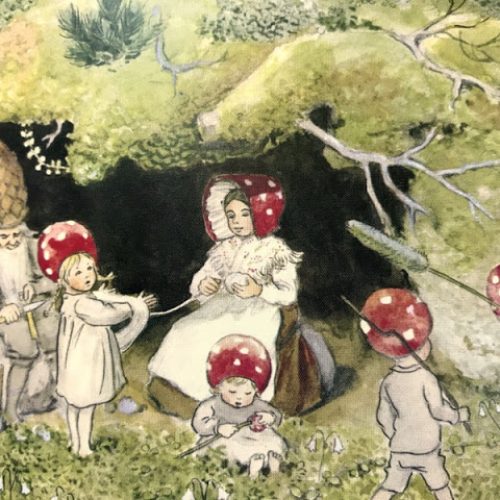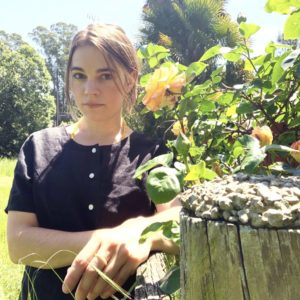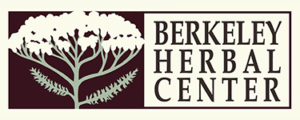
As the seeds sleep, warmed by the ember at the center of the earth, the darkness seeps deeper into our world. It is in the dark that we truly see. As we slowly walk the quiet spiral into the heart of winter, illuminated by a single beeswax flame, the otherworld reaches out.
Listening closely, we hear the Baba Yaga cackling as she flies through the night. We hear gnomes dancing with house cats as they eat offerings of porridge and warm butter. We hear ancestors weaving stories by the hearth and we hear the muffled voices of mushrooms as they awaken, hatching like earthen eggs under blankets of falling leaves.
It is here she dwells, slipping through the icy air. The tender of winter, the midwife of death. She is the Baba , the Crone, the Winter Witch whose ice cold gaze brings death while her worn hands knot and weave and braid the cords that tie the world together. Casting her net of creation over the barren earth, she speaks her spells in the weave of spider webs, the lace symbols of frost-covered earth. She is the one spinning dreams that come in the long cold nights.
By the light of the hearth fire she has a kinder face. She is also known as Hestia of the hearth, La Befana the bringer of gifts, the Solstice Queen, who ushers in the return of the sun. Chanting as she sweeps, whispering spells as she mends socks, telling prophecy in dripping beeswax candles and the cracks of baking dough in the oven.
For it is from the dark that the light glows, from death that the seed grows, from dreams that spirit whispers.
As we step ever further into darkness and its deepest seed, the Winter Solstice, it becomes tempting to try and shut out the discomfort that comes with this season. To exchange the cold, dark and damp for the domestic comfort within the home.
This separation often leads to drawing distinctions – between light and dark, cold and warm, good and bad, domestic and wild.
Yet it is at this moment that we are invited to see that it is in the dark that we can create anew, like the black fertile soil that nourishes the seed. We are called to go slow and listen to the howling winds, and barren fields, the leafless trees and empty garden beds. To see the life that unfurls from nothing. And maybe even to offer something back.
For at the Winter Solstice, we again sit at the knot between worlds. And by inviting those beings that dwell in the depths and dark of winter into our home they become kin. Making a richer, fuller cloak of connection that not just acknowledges the darker, shadow, wilder sides of life but invites it to the table to feast with us and tell stories around the fire.
In my garden, the compost pile becomes the center. The warm hearth fire that I tend this time of year. Bringing offerings of honey, fallen leaves, ashes or scraps of dinner.
I take cold walks to visit the dreaming roots and mushroom folk tucked into blankets of sweetly fermenting leaves. It is a time to lean into the magic of slowness. Allowing the waters within to settle, so that you can peer into the black reflective mirror within and see what arises.
In much of European folklore this is a time of year for divination, of looking into the unknown. It was also a time of giving thanks, in particular to the invisible forces, the ancestors or spirits of the home and the land. Sometimes known as the Gome, Nisse, Tomte, Brownies or Domovoi just to name a few.
And as we approach the longest night of the year, which in ancient times was a celebration of the return of the sun, we are invited again to put faith in and even celebrate the invisible world that lies in the darkness beyond the candles flame. For it is at the moment we relinquish control and step into the flow that we can begin to feel the web that holds us.
For this leap of faith I turn to the plants for support, in particular to the study energy of tree magic.
Evergreens including Pines, Cedar or Juniper whose greenery is often the only visible symbol of life at this time of year hold an ancient air of grounding energy that is undeniably comforting.
Evergreens also carry the energetics of the sun within their fragrant boughs. This is welcome in a time when the sun feels so cold and distant.
Pine needles steeped in hot water makes a warming, Vitamin C rich winter tea. Adding Evergreens to baths or to a simmering pot on the stove releases their volatile oils, which are relaxing, cleansing and clearing for the respiratory system.
Many evergreens when dried make a sweet smelling smoke for burning. So while the wind is howling and your toes are struggling to keep warm, consider letting the dark come a little closer, held back by a single candle. While you sip, smell or sit with a token of greenery and see what magic comes out of the dark.
Author Bio:

Sami with Cinder Botanica. Sami is a clinician at our Community Herbal Center and uses bees, herbs, and a deep connections to the cycles of the planet in her regular herbal practice.
You can contact her to schedule an appointment by emailing clinic@berkeleyherbalcenter.org or find her on Instagram @cinder.botanica.
Support Our Work
Berkeley Herbal Center is a 501(c)(3) organization, so all donations are tax deductible. Tax ID #14-1975183
If you would like to donate by check or cash, please send an envelope addressed to:
Berkeley Herbal Center
1250 Addison St., #G
Berkeley, CA 94702

